In our Thursday article, we talked about a “quiet shift” in the markets from growth stocks to value—and we named 2 CEFs yielding 9%+ that are primed to profit from it.
Yes, the recent jump in volatility is a big reason for that. So today, we’re going to look at another side of the rotation we’re seeing—a shift from passive to active investing.
Index Funds Are So 2023
As we move further into 2025, it’s getting clearer to me that we’re in a stock picker’s market. Sitting in an index fund just won’t cut it.
That said, at my CEF Insider service, we’re still bullish on stocks (and stock-focused closed-end funds, many of which hand us 8%+ yields), and we’ll get into two stock-focused funds, along with another that holds preferred stocks—kind of a stock/bond hybrid—below.
Because there’s no question that success in this market will require active management—moving into, and out of, the right stocks and sectors at the right times.
Of course, many mainstream investors aren’t interested in that—it’s too much work!
This is why I’m betting that many of them are likely to give CEFs a closer look as we move further into 2025. As they do, they’ll discover what we’ve known at CEF Insider for years: CEFs let you sit back and collect high yields (and price upside) while “farming out” picking the actual investments to a professional human manager.
That makes now a great time to pick up some well-run CEFs as active management (finally!) regains appeal.
8%+ Dividends Now on Sale
Doing so lets us buy our CEFs at a discount to net asset value (NAV, or the value of their underlying portfolios), especially in the wake of the recent selloff. Then, as more investors pile in, we get to ride along as those discounts shrink, pulling our CEFs’ market prices higher as they do.
Which brings me back to those three CEFs I mentioned off the top—the Liberty All-Star Growth Fund (NYSE:ASG)—a CEF Insider holding—the SRH Total Return Fund (NYSE:STEW) and the Flaherty & Crumrine Preferred and Income Securities Fund (NYSE:FFC). All are trading at discounts and boast dividends that are either sky-high (9.4% in the case of ASG) or set to grow (like STEW’s 4%-yielding payout).
CEF #1: Liberty All-Star Growth Fund (ASG)
ASG is a multi-manager fund that invests in large-, mid-, and small-cap growth stocks. This means it leverages the knowledge of experts in different sectors (tech, financial, etc.), as well as experts with experience investing in big companies, small companies and everything in between.
ASG is interesting now because, in a sense, it gives us two discounts. The first is the fund’s discount to NAV, which is 7.9% as I write this, even though the fund has delivered an 8.4% annualized total return over the last decade, based on its market price, as of this writing.
That 7.9% discount is well below its five-year average of 1%, which is our first discount here. The other one is on the fund’s stocks themselves, and we can see the recent dip in those by looking at its NAV performance, including dividends. That’s entirely the result of the last few weeks of volatility:
ASG’s Portfolio Soars, Then Dips—Giving Us An In
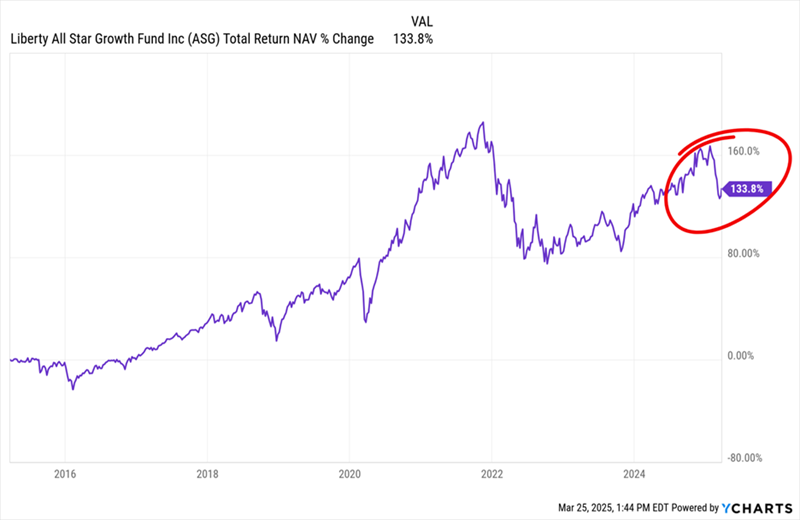
Meanwhile, ASG offers a rich 9.4% dividend yield. Unlike ETFs, which typically provide minimal yield, ASG’s managed-distribution policy (meaning ASG management can raise or lower payouts depending on what’s best for the fund’s long-term returns.
Moreover, ASG’s overall yield is actually higher than it looks, since management regularly pays special dividends.
9.4% Is a “Yield Floor,” Not a Ceiling
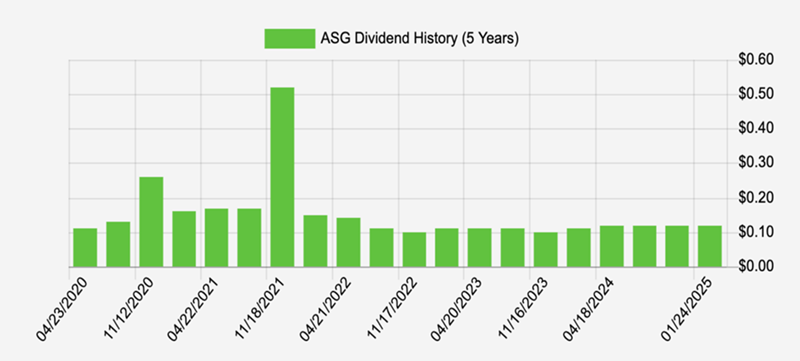
Source: Income Calendar
With a discount to NAV and a dip in its portfolio performance, ASG is set up to gain as more investors “farm out” their stock picking. Buy it now and we could collect that 9.4% “base” payout in the meantime.
CEF Pick #2: SRH Total Return Fund (STEW)
Next up is the SRH Total Return Fund, which sports one of the biggest discounts in CEFs, at 23.1%. That’s wild when you consider that STEW delivered a tidy 12.7% annualized return over the last decade.
Moreover, that 23.1% discount is nearly five percentage points wider than STEW’s long-term average of 18.2%.
Profits (Orange) Go Up, Pricing (Purple) Goes Down
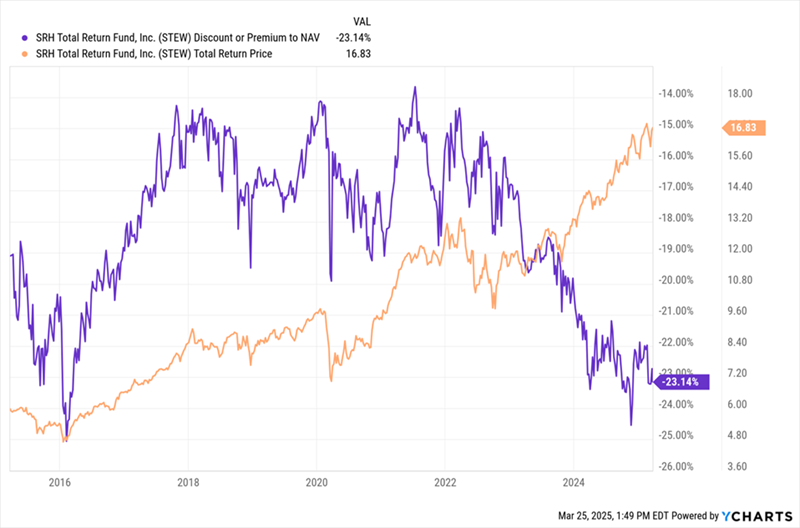
STEW’s top holdings include Berkshire Hathaway (NYSE:BRKa) (NYSE:BRKb), which comprises nearly 40% of the portfolio between the two share classes, as well as other well-known large caps, like JPMorgan Chase (NYSE:JPM), Cisco Systems (NASDAQ:CSCO) and pipeline master limited partnership (MLP) Enterprise Products Partners (NYSE:EPD).
So why is this fund trading at such a deep discount? Simply put: neglect. STEW doesn’t have the same name recognition as some larger CEFs. But with markets now rewarding active strategies and investors looking to large caps during this volatility, that’s set to change.
STEW is also valuable because management can put 40% of their portfolio in stocks like BRK when they’re undervalued, while SEC rules limit passive funds to stick to no more than about 10% of their assets in any one holding.
Once investors pick up on STEW’s strong performance and deep discount, the gap should narrow. And with a very well-covered dividend, you’re very likely to see higher payouts over time, building on the 4% yield you’d get on a buy made today. In fact, history strongly suggests that’s exactly what’ll happen here:
STEW’s Accelerating Dividend Growth
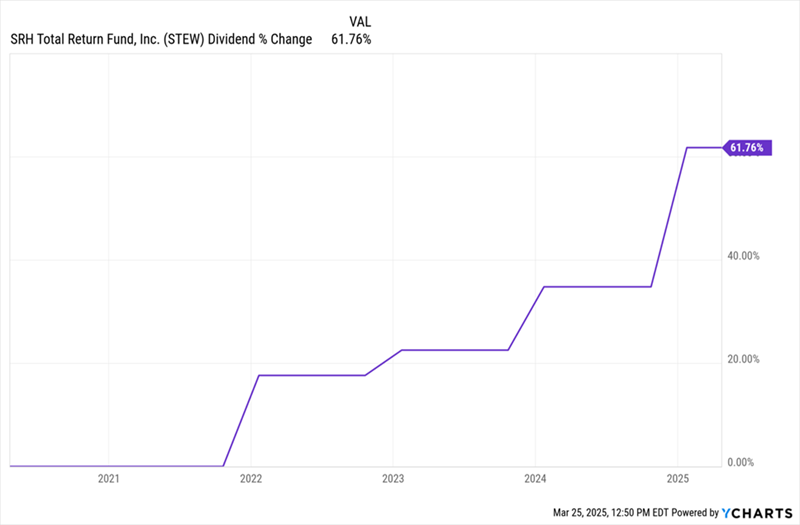
Just in the past five years, STEW’s payout has jumped 62%, and as you can see at the right of this chart, its payout growth is accelerating. That bodes well for anyone buying this bargain-priced CEF today.
CEF Pick #3: Flaherty & Crumrine Preferred Securities Income Fund (FFC)
The Flaherty & Crumrine Preferred Securities Income Fund (FFC) holds preferred shares, which trade on an exchange, like stocks, and represent ownership in a company. But their price movements are more like those of bonds. And, like bonds, they’re sensitive to interest rates. More on that in a second.
Banks and insurance companies are the main issuers of preferreds, which is why 54% of FFC’s portfolio consists of financial services firms, with preferreds from the likes of Wells Fargo and MetLife (NYSE:MET). That’s something to keep in mind when you’re considering how FFC fits into your overall portfolio weighting.
Beyond that, the fund is a good way to pick up a basket of preferreds and lock in a 6.8% yield while doing so.
FFC’s Payout Flows With Rates
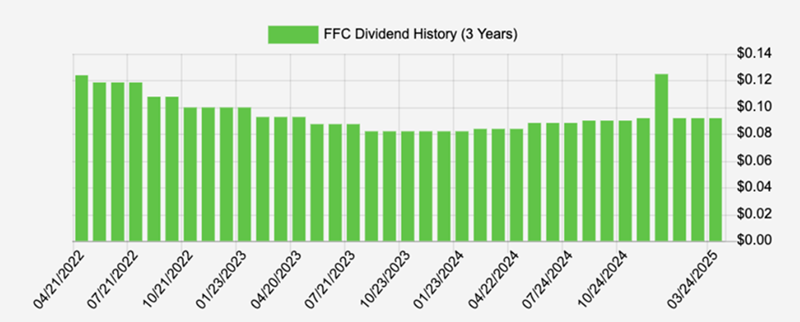
Source: Income Calendar
Above you can see the rate sensitivity of FFC’s dividend in action, with the payout moving lower as rates rose in 2022 and 2023, then steadying and rising as rates topped out and began to move lower (along with a special dividend late last year).
Here’s what makes FFC particularly interesting now: It historically trades at a premium to NAV of 1%, but it’s currently at a 5.8% discount. That’s a big break from its norm, and it’s unlikely to last.
Higher Profits and a Bigger Discount
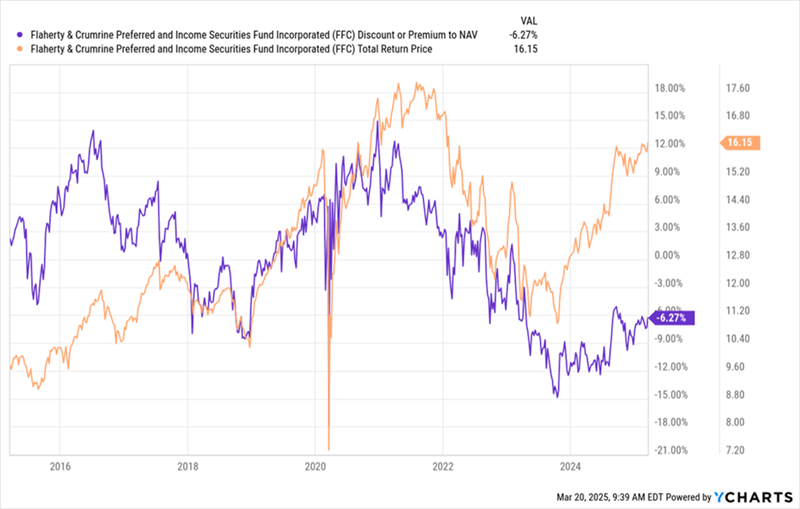
Preferred securities tend to do well when rates are stabilizing, and that’s where we are now, with Jay Powell saying he’s content to hold off on further cuts until the effects of Trump administration policies (especially around tariffs) become clearer.
Even so, the latest projections from the Federal Open Market Committee do still indicate that two rate cuts are expected in 2025, probably toward the end of the year.
When that happens, preferreds will benefit, and funds like FFC are likely to see renewed interest—which I see pushing the fund’s discount back toward a premium. That leaves us with FFC’s 6.8% dividend (with potential for more payout growth) to collect while we wait.
Disclosure: Brett Owens and Michael Foster are contrarian income investors who look for undervalued stocks/funds across the U.S. markets. Click here to learn how to profit from their strategies in the latest report, "7 Great Dividend Growth Stocks for a Secure Retirement."
Which stock should you buy in your very next trade?
With valuations skyrocketing in 2024, many investors are uneasy putting more money into stocks. Unsure where to invest next? Get access to our proven portfolios and discover high-potential opportunities.
In 2024 alone, ProPicks AI identified 2 stocks that surged over 150%, 4 additional stocks that leaped over 30%, and 3 more that climbed over 25%. That's an impressive track record.
With portfolios tailored for Dow stocks, S&P stocks, Tech stocks, and Mid Cap stocks, you can explore various wealth-building strategies.
